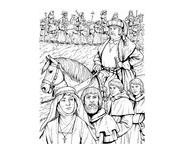
Pilgrimage to Meryem Ana Evi
ON HOLY GROUND
On a misty mid-January morning earlier this year, my husband, older son, and I were driven by our hotel host, Adem, southwest out of Selçuk, Turkey (pronounced “sell-chuck,” about two miles from Ephesus), and up Bülbül Dag (Nightingale Mountain). Our destination was the House of Mother Mary, or Meryem Ana Evi as the Turks know it. As we rose higher and higher on the winding mountain road, views of the Aegean Sea on one side, and the agricultural town of Selçuk (reminiscent of small Irish towns with tractors chugging down the main street) on the other, alternately opened up before us. We could still see wisps of mist in the low-lying areas, but within minutes we were in full radiant sun.
In another few minutes we had completed the 5.6-mile journey, arriving in a wooded, park-like area. A large parking lot has been built to accommodate tour buses, but on this particular day, there were only a handful of cars. (January is the off-season.) We walked up the path, past the inevitable vendors of postcards, icons, and other holy items (profane items too), past the olive trees planted by priests of the Vincentian order, and the statue of Mary that greets visitors, and past the covered outdoor area adjacent to the house where Popes John Paul II and Benedict XVI said Mass when they visited the site in 1979 and 2006, respectively (daily and Sunday Masses are regularly celebrated here).
Once inside, I was struck with the simplicity and elegance of this house-become-chapel. Sadly, for this shutterbug, photography is not allowed inside the chapel. On the positive side, I was released from involvement with a mechanical contrivance that can obscure or obstruct the real experience of being in a place. A lone nun was praying before the altar, and I too knelt to pray. (Because of the special status accorded to Mary in Islam, Muslims are often seen performing namaz — prayer — in this chapel, although none was present this day.) A soberness and peacefulness borne of gratitude overwhelmed me. The deep stillness I felt brought me close to tears, but few words came. How does one describe simultaneous joy and sorrow?
You May Also Enjoy
Only by innocence and goodness can anything lasting in significance and truly beautiful be created.
The mental image most people have of Our Blessed Mother has probably been generated and…
Karl Barth, speaking for classical Reformation theology, wrote in his Church Dogmatics: “In the doctrine…

